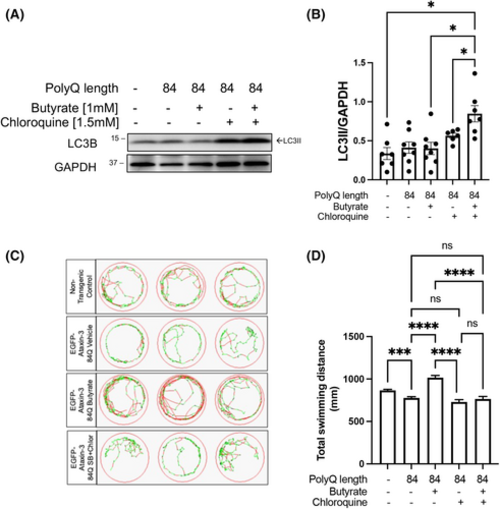
Treatment with sodium butyrate induces autophagy in the SCA3 zebrafish model producing beneficial effects on zebrafish swimming. (A) Western blots were performed on protein lysates from non-transgenic controls and ataxin-3-84Q zebrafish larvae treated with either 1 mM sodium butyrate (SB) alone, 1.5 mM chloroquine alone or co-treatment of SB and chloroquine, between 1 and 6 days post fertilization (dpf). The immunoblots were probed for LC3B. (B) Quantification of LC3II levels after treatment with 1 mM SB and/or 1.5 mM chloroquine found an increase with SB and chloroquine treatment compared to chloroquine treatment alone, SB treatment alone, and the non-transgenic controls (p = .0475, p = .0395 and p = .0303, respectively; n = 6–8). (C) Swimming trajectories of non-transgenic and SCA3 zebrafish treated with either vehicle control, 1 mM SB, 1.5 mM chloroquine, or SB/1.5 mM chloroquine and show that SB increases the amount of fast swimming and SB/chloroquine co-treatment decreases this (green, slow movement; red, fast movement). (D) Quantification of the total distance swum by each animal demonstrates that vehicle-treated SCA3 zebrafish has decreased swimming distance (p = .0009), SB treatment rescues the motor impairment seen in vehicle-treated ataxin-3-84Q zebrafish (p < .0001), and those receiving 1.5 mM chlor or SB/chlor co-treatment (p < .0001 and p < .0001, respectively, n = 81–260). Data represent mean ± SEM. Statistical analysis was performed using a one-way ANOVA followed by a Tukey post hoc test. ns, non-significant. *p < 0.05, ****p < 0.0001.
|

